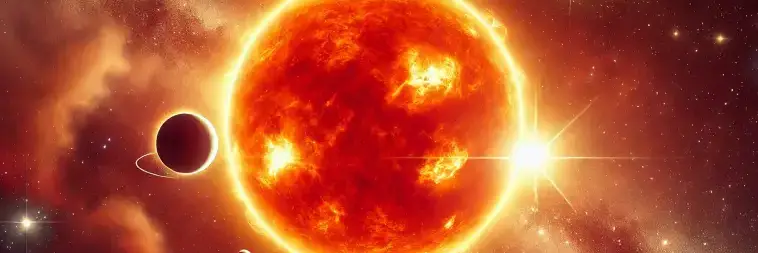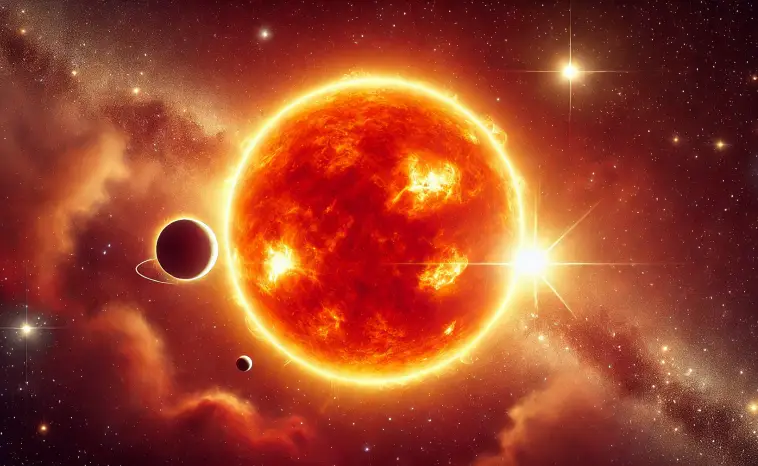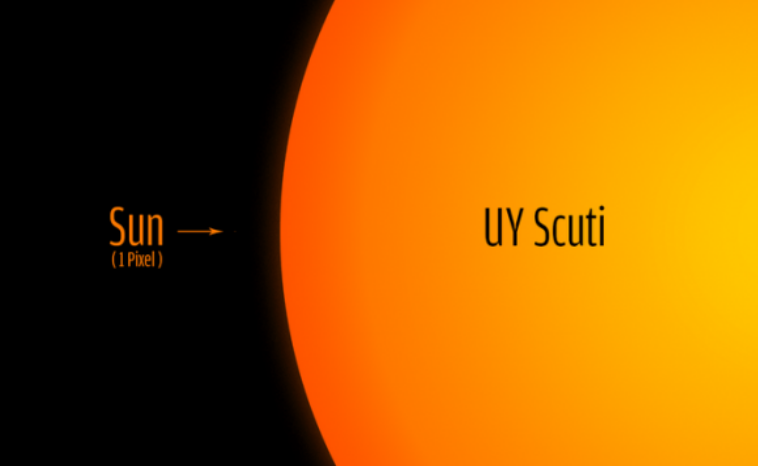The Biggest Stars in the Universe

Discover the biggest stars in the universe, including UY Scuti. Learn how large stars shape the cosmos and compare UY Scuti vs the Sun.
Those stars twinkling above us might seem small and distant, but in reality, they’re pretty massive. In fact, some of them are cosmic giants beyond our wildest imagination! Yes, the universe is home to enormous stars that dwarf our Sun, stretching the limits of size and mass. But what are the biggest stars in the universe, and just how big can a star really be? Let’s explore the largest stars in the universe and uncover their incredible scale!
How Big Is a Star? Understanding Stellar Sizes

Stars come in all sizes, from (relatively) tiny red dwarfs to colossal supergiants. Their size depends on factors such as their mass, temperature, and life cycle stage. Unlike planets, which have well-defined solid surfaces, stars are massive balls of gas, meaning their outer edges are more diffuse and harder to gauge precisely. Scientists typically measure stars by their radius and volume in comparison to the Sun, which serves as a handy reference point.
Our Sun has a radius of about 696,000 km. That sounds pretty big, right? At least until you realise that some of the biggest stars in the universe are hundreds or even thousands of times larger! These stars have expanded due to the intense heat and pressure in their cores, making them the true giants of the cosmos.
The Biggest Stars in the Universe
Among the largest stars in the universe, a few stand out for their incredible size and luminosity. Let’s take a look at some of these celestial titans!
UY Scuti: The Biggest Star in the Universe?
One of the most famous contenders for the title of the biggest star in the universe is UY Scuti. Located in the constellation Scutum, UY Scuti is a red supergiant with an estimated radius around 1,700 times that of the Sun. If you dropped it in the centre of our Solar System, UY Scuti would extend beyond the orbit of Jupiter!
UY Scuti vs Sun: A Cosmic Comparison

CREDIT: TheNerdSatan, CC BY-SA 4.0, via Wikimedia Commons
CREDIT: TheNerdSatan, CC BY-SA 4.0, via Wikimedia CommonsTo understand the sheer scale of UY Scuti, let’s compare it to our Sun:
- Radius: UY Scuti is about 1,700 times larger than the Sun.
- Volume: It could fit over 5 billion Suns inside it.
- Brightness: UY Scuti is significantly more luminous than the Sun, though its outer layers are much cooler.
However, while UY Scuti could well be the largest star we know about, it’s not the most massive star. Its size is undoubtedly enormous, but astronomers estimate its mass to be only about 30 times that of the Sun. That’s because supergiant stars have low-density outer layers, making them certainly vast – but not necessarily heavy on a solar scale.
Other Large Stars in the Universe
UY Scuti is definitely impressive, but there are other large stars in the universe that rival its size or mass:
- VY Canis Majoris: Once the largest star we knew about, VY Canis Majoris is another red supergiant located in the constellation Canis Major. Estimates place its radius between 1,400 and 2,100 times that of the Sun, making it a true behemoth. Like UY Scuti, astronomers expect its life to end in a dramatic supernova explosion, leaving behind a black hole or neutron star.
- Betelgeuse: One of the most famous red supergiants, Betelgeuse is located in the Orion constellation and is visible to the naked eye. It has a radius around 1,000 times that of the Sun, but what makes it particularly intriguing is its impending supernova. Scientists predict that within the next 100,000 years, Betelgeuse will explode, briefly outshining the entire galaxy before quickly fading away.
- RW Cephei: This hypergiant star, found in the constellation Cepheus, has an estimated radius over 1,500 times that of the Sun. It is among the largest stars by volume, though its exact size is still a matter for debate. RW Cephei is also a variable star, meaning its brightness fluctuates over time due to internal processes and mass loss.
- Stephenson 2-18: Possibly the largest star we’ve seen to date, Stephenson 2-18 is a red supergiant in the massive Stephenson 2 star cluster. Some measurements suggest it could be even bigger than UY Scuti, with an estimated radius over 2,100 times that of the Sun. However, due to the challenges of measuring such vast and diffuse stars, its true size remains a mystery for now.
The Life and Death of a Supergiant Star
Large stars in the universe burn through their fuel at an incredible rate, leading to spectacular ends. While our Sun will quietly expand into a red giant and then shrink into a white dwarf, stars like UY Scuti will explode in a supernova, leaving behind either a neutron star or a black hole.
Supergiant stars only live for a few million years—a blink of an eye in cosmic terms—compared to smaller stars like the Sun, which can shine for billions of years. Their brief but dramatic lives shape the universe, creating all the necessary elements for planets, life, and even future generations of stars.
Final Thoughts on the Biggest Stars in the Universe
The universe is full of astonishing wonders, and the biggest stars remind us just how vast and dynamic space truly is. Whether it’s the enormous scale of UY Scuti or the fiery fate of Betelgeuse, these celestial giants shape the cosmos in ways we are only beginning to understand.

While these enormous stars are far beyond our Solar System, they can still be observed with telescopes and star-mapping tools. With the OSR Star Finder App, you can explore the night sky and locate some of the biggest stars in the universe. Download the app and start your own stellar journey today!

